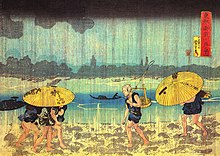Sumida (river)
| Sumida | ||
|
Sumida in Tokyo |
||
| Data | ||
| location | Tokyo, Japan | |
| River system | Arakawa | |
| origin | Arakawa River at Shin Iwabuchi Lock 35 ° 47 ′ 12 ″ N , 139 ° 43 ′ 56 ″ E |
|
| muzzle |
Tokyo Bay Coordinates: 35 ° 39 ′ 13 " N , 139 ° 45 ′ 59" E 35 ° 39 ′ 13 " N , 139 ° 45 ′ 59" E
|
|
| length | 23.5 km | |
|
The Sumida at night |
||
The Sumida ( Japanese 隅田川 , -gawa ) is a river in Japan .
The Sumida separates from the Arakawa at Shin-Iwabuchi Lock in Tokyo's Kita district , flows through Tokyo and flows into Tokyo Bay . The Sumida flows through the old bed of the Arakawa, which was diverted in the early 20th century to prevent flooding. Before the 17th century, when the Tone (river) was diverted eastwards and the Arakawa separated from it, the Sumida was the lower reaches of the Iruma , which has been a tributary of the Arakawa ever since.
The river gave Tokyo's Sumida district its name, but the first Japanese character for the district name is derived from an alternative name for the river bank ( 墨 堤 ). Tourist boats operate on the Sumida, from which there is a spectacular view of the skyline of the Japanese capital.
The Sumida flows through the following districts of Tokyo :
The Sumida once formed the border between the provinces of Musashi and Shimousa , which gave the large bridge over the Sumida the name "Two-Country Bridge" (Ryōgoku-bashi). Later the east side of Sumida came to Musashi Province, but the name stuck.
Fireworks
Under the name Sumidagawa Hanabi Taikai (隅田川 花火 大会), a large fireworks display has been set off over the river on the last Saturday in July near Asakusa since 1978 .
Corresponding events were established at the Ryōgoku Bridge (両 国 橋 Ryōgoku-bashi) over the Sumida as Ryōgoku Kawabiraki (両 国 川 開 き) since 1810, with various associations of fireworkers, primarily the Tamaya (玉 屋) and the Kagiya (鍵 屋) competed. The representation of such fireworks can be found as sheet 98 in Hiroshige's series of woodcuts 100 Famous Views of Edo (1856–58).
In the 1920s, with the Kantō earthquake on September 1, 1923, other worries were to be had, and the tradition of large fireworks over the Sumida ended until it was revived in 1978.



